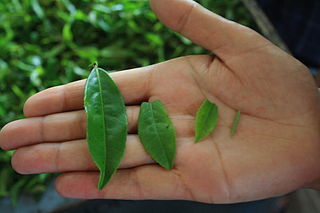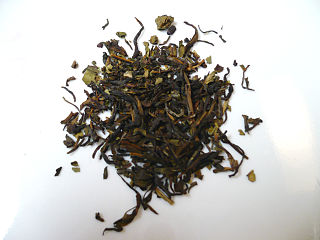
Oolong (, ; Chinese: 烏龍茶 is a traditional semi-oxidized Chinese tea produced through a process that includes withering the leaves under strong sun and allowing some oxidation to occur before curling and twisting. Most oolong teas, especially those of fine quality, involve unique tea plant cultivars that are exclusively used for particular varieties. The degree of oxidation, which is controlled by the length of time between picking and final drying, can range from 8% to 85% depending on the variety and production style. Oolong is especially popular in southeastern China and among ethnic Chinese in Southeast Asia, as is the Fujian preparation process known as the gongfu tea ceremony.

Tea is an aromatic beverage prepared by pouring hot or boiling water over cured or fresh leaves of Camellia sinensis, an evergreen shrub native to East Asia which probably originated in the borderlands of southwestern China and northern Myanmar. Tea is also made, but rarely, from the leaves of Camellia taliensis. After plain water, tea is the most widely consumed drink in the world. There are many different types of tea; some have a cooling, slightly bitter, and astringent flavour, while others have profiles that include sweet, nutty, floral, or grassy notes. Tea has a stimulating effect in humans, primarily due to its caffeine content.

White tea may refer to one of several styles of tea which generally feature young or minimally processed leaves of the Camellia sinensis plant.

In the tea industry, tea leaf grading is the process of evaluating products based on the quality and condition of the tea leaves themselves.

Nilgiri tea is a drink made by infusing leaves of Camellia sinensis that is grown and processed in the Nilgiris district in Tamil Nadu, India. The leaves are processed as black tea, though some estates have expanded their product offerings to include leaves suitable for making green, white and oolong teas. It is generally described as being a brisk, fragrant and full-bodied tea. The region produces both rolled and crush, tear, curl tea and it is predominantly used for blending. Nilgiri tea is also used for making iced tea and instant tea.

Dianhong tea is a type of relatively high-end, gourmet Chinese red tea sometimes used in various tea blends and grown in Yunnan Province, China. The main difference between Dianhong and other Chinese red teas is the amount of fine leaf buds, or "golden tips," present in the dried tea. Dianhong tea produces a brew that is brassy golden orange in colour with a sweet, gentle aroma and no astringency. Cheaper varieties of Dianhong produce a darker brownish brew that can be very bitter.

Darjeeling tea is a tea made from Camellia sinensis var. sinensis that is grown and processed in Darjeeling district or Kalimpong district in West Bengal, India. Since 2004, the term Darjeeling tea has been a registered geographical indication referring to products produced on certain estates within Darjeeling and Kalimpong. The tea leaves are processed as black tea, though some estates have expanded their product offerings to include leaves suitable for making green, white, and oolong teas.

Tea blending is the act of blending different teas together to produce a final product that differs in flavor from the original tea used. This occurs chiefly with black tea, which is blended to make most tea bags, but it can also occur with such teas as Pu-erh, where leaves are blended from different regions before being compressed. The most prominent type of tea blending is commercial tea blending, which is used to ensure consistency of a batch on a mass scale so that any variations between different batches and seasons of tea production do not affect the final product. However, it is also common to blend tea leaves with herbs and spice, either for health purposes or to add interesting and more complex flavor notes. It is important that any one blend must taste the same as the previous one, so a consumer will not be able to detect a difference in flavor from one purchase to the next.
Camellia sinensis, the source of tea leaves and buds, can be grown in much of the United States. Commercial cultivation has been tried at various times and locations since the 1700s, but tea has remained a niche crop and has never been cultivated widely in the US. As of 2020, the US mainland has one relatively large plantation with full mechanization in Charleston, South Carolina, and many small commercial tea gardens that pick tea by hand. Some growers feel that tea production is not economically viable without some mechanization, but there is evidence that unmechanized tea production is viable, albeit with lower net profit margins. Most domestically grown teas are available through mail order and online purchases.

Irish breakfast tea is a blend of several black teas, most often a combination of Assam teas and Ceylon teas. Irish tea brands, notably Barry's, Bewley's, Lyons and Robert Roberts in the Republic and Nambarrie's and Thompson's Punjana in Northern Ireland are heavily weighted towards Assam. It is one of the most popular blended teas, common in tea culture in Ireland. When tea was first transported from China to Ireland in the mid-18th century, it was mainly introduced to the wealthy as a result of its high cost and low demand. However, throughout the mid-19th century, Irish breakfast tea became readily available to those of both lower and higher socioeconomic classes.
Coffee production is a significant contributor to the economy of Kenya. The industry is noted for its cooperative system of production, processing, milling, marketing, and auction system. About 70% of Kenyan coffee is produced in small farms that control about 75% of the land under production. It was estimated in 2012 that there were about 150,000 coffee farmers in Kenya. Other sources suggest that 6 million Kenyans are employed directly or indirectly in the coffee industry.

Tea tasting is the process in which a trained taster determines the quality of a particular tea. Due to climatic conditions, topography, manufacturing process, and different cultivars of the Camellia sinensis plant (tea), the final product may have vastly differing flavours and appearance. A trained tester can detect these differences and ascertain the tea's quality prior to sale or possible blending.

Tea processing is the method in which the leaves from the tea plant Camellia sinensis are transformed into the dried leaves for brewing tea.

Agriculture in Indonesia is one of the key sectors within the Indonesian economy. In the last 50 years, the sector's share in national gross domestic product has decreased considerably, due to the rise of industrialisation and service sector. Nevertheless, for the majority of Indonesian households, farming and plantation remains as a vital income generator. In 2013, the agricultural sector contributed 14.43% to national GDP, a slight decline from 2003's contribution which was 15.19%. In 2012, the agricultural sector provides jobs to approximately 49 million Indonesians, representing 41% of the country's total labor force.

Matcha (抹茶) ; is a finely ground powder of specially grown and processed green tea leaves that originated in China. Later, the green color exhibited in most modern matcha was developed in Japan, where most matcha is produced today. In the 12th century at the latest, Chinese compressed tea, the raw material for matcha, was introduced to Japan. When the production of compressed tea was banned in China in 1391, matcha was abandoned in China and developed in Japan thereafter.

Coffee production in Tanzania is a significant aspect of its economy as it is Tanzania's largest export crop. Tanzanian coffee production averages between 30,000 and 40,000 metric tons annually of which approximately 70% is Arabica and 30% is Robusta.

Congou is a description of a black Chinese tea variety used by 19th-century tea importers in America and Europe. It was the base of the 19th-century English Breakfast tea blend.
Kenya Tea Development Agency Holdings (KTDA) is a Kenyan company that provides comprehensive services to more than 600,000 small tea farmers such as agri-extension, transportation, processing, and marketing.

Sri Lanka has a climate and varied elevation that allows for the production of both Camellia sinensis var. assamica and Camellia sinensis var. sinensis, with the assamica varietal holding the majority of production. Tea production is one of the main sources of foreign exchange for Sri Lanka, and accounts for 2% of GDP, contributing over US$1.3 billion in 2021 to the economy of Sri Lanka. It employs, directly or indirectly, over 1 million people, and in 1995 directly employed 215,338 on tea plantations and estates. In addition, tea planting by smallholders is the source of employment for thousands whilst it is also the main form of livelihood for tens of thousands of families. Sri Lanka is the world's fourth-largest producer of tea. In 1995, it was the world's leading exporter of tea, with 23% of the total world export, and Sri Lanka ranked second on tea export earnings in 2020 after China. The highest production of 340 million kg was recorded in 2013, while the production in 2014 was slightly reduced to 338 million kg. India has additionally guaranteed Sri Lanka a shipment of 65,000 metric tons of urea. Sri Lanka's troubled execution of an organic agriculture initiative had pushed the country perilously close to an agricultural crisis. Given the surge in global fertilizer prices, it is improbable that Sri Lanka could procure fertilizer at prevailing market rates.

Black tea is a type of tea that is more oxidized than oolong, yellow, white and green teas. Black tea is generally stronger in flavour than other teas. All five types are made from leaves of the shrub Camellia sinensis, though Camellia taliensis is also used rarely.


















